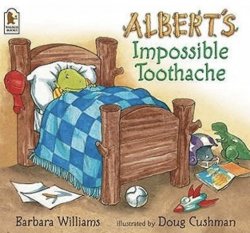Gareth B. Matthews

Review of Albert’s Impossible Toothache by Barbara Williams (New York: E.P. Dutton, 1974). Originally published in Thinking: The Journal of Philosophy for Children 2(1): 3.
Albert is a turtle, who complains that he has a toothache. Albert’s father is quite unsympathetic. “That’s impossible,” he says; “it is impossible for anyone in our family to have a toothache.” Though Albert’s father does point to his own toothless mouth (does he also point to its toothlessness?) to establish the impossibility of a turtle’s having a toothache, he never actually says to Albert, “To have a toothache you need to have a tooth and turtles don’t have teeth.”
Wouldn’t it have been much better to tell Albert that he can’t have a toothache because he doesn’t have any teeth? Perhaps Albert can have a tailache; but he doesn’t have the right equipment for having a toothache.
It isn’t even enough just to have a tooth (for example, under one’s pillow). One can’t have an ache in x unless x is a part of one’s very own body. Indeed, for y to be able to have an ache in x at a particular time, t, x must be an integral part of y’s body at t.
But is that last claim really satisfactory? Descartes was impressed by the fact that amputees sometimes report having aches and pains in their amputated limbs (the phenomenon of the “phantom limb”). Suppose that, while I am unconscious, my last remaining tooth is extracted and, when I wake up, I report having an awful toothache. Is it false that I then have a toothache, since I then have no tooth? And what do I have instead? A jawache? But suppose it doesn’t feel like a jaw ache? (I’ve had those, too). “It’s just in your head,” someone might say. Perhaps so. But it’s not a headache. (Nor, of course, is it a brainache!).
Albert’s grandmother is the only character in the story who is sympathetic to Albert. To her he explains that his “toothache” is on his left toe. Albert’s explanation makes it hard to avoid the conclusion that he simply doesn’t know what a toothache is.
How does one learn what a toothache is? By having one? And how does one first know it is a toothache one has? Doesn’t it go this way? I come to learn that I have various anatomical parts, including teeth. Once I know a little about my own anatomy I immediately know where I hurt without having to learn how to tell. Then, so long as I know I have a tooth, I am in a position to recognize that an ache or pain I have is in my tooth.
But there are complications. Suppose the dentist says there is nothing wrong with my tooth? Can the dentist tell me I don’t have a toothache?
Perhaps what the dentist will say (it’s what a dentist said to someone I know) is that, my tooth being sound, what I have is a simulated toothache. Is this something Albert could have had?
Then there is the ache in the phantom tooth. And if one can have an ache in a tooth one no longer has, why not in a tooth one never had?
Albert’s grandmother takes a hand kerchief from her purse and wraps it around Albert’s toe. I don’t know whether that treatment would help a simulated toothache, or an ache in a phantom tooth, but it seems to have been just what Albert needed.
